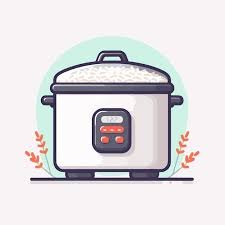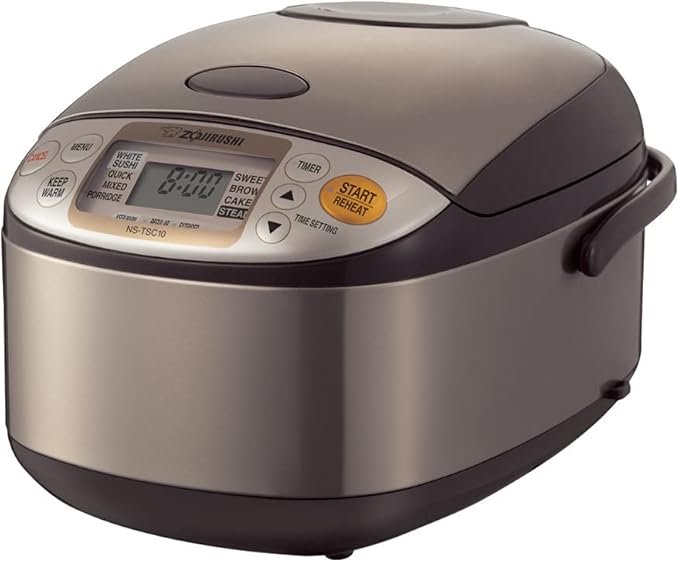If you’re serious about perfecting your rice game, you’ve likely come across terms like Micom and Neuro Fuzzy while researching rice cookers. But what exactly do these buzzwords mean, and how do they impact the quality of your rice? Let’s dive into the world of advanced rice cooker technology to break down the key differences between Micom and Neuro Fuzzy rice cookers, and help you decide which one is worth bringing into your kitchen. Plus, we’ll suggest some top-performing products from Zojirushi to make your decision even easier.
What is Micom Technology?
Micom stands for microcomputer-controlled technology, which is exactly what powers these rice cookers. With Micom technology, rice cookers go beyond just turning rice on and off. They automatically adjust cooking times and temperatures, ensuring the perfect batch of rice every time, regardless of the type of grain or how much water you’ve added.
Advantages of Micom Rice Cookers:
Smart Adjustments: Micom rice cookers automatically fine-tune the temperature and cooking duration based on the rice type (white, brown, sushi rice, etc.) and even detect errors in measurements, compensating to make sure the rice turns out perfect.
Versatile Functions: Most Micom rice cookers are multi-functional, often allowing you to steam vegetables, bake cakes, or even cook soups and porridge with just a few button presses.
Affordable for Advanced Tech: While offering precise cooking, Micom rice cookers tend to be more affordable than those with Neuro Fuzzy technology, making them a great value for those looking to upgrade from basic rice cookers.
Recommended Product: Zojirushi NS-TSC10
One of the best examples of a Micom rice cooker is the Zojirushi NS-TSC10. This model holds up to 5.5 cups of uncooked rice and can handle white, brown, mixed, and sushi rice with ease. It also offers a cake-baking setting and a steaming function, making it a versatile kitchen companion. The Quick Cook setting is perfect for those who need rice fast without sacrificing too much texture. At a price point around $150–$180, it’s a smart, budget-friendly investment for anyone wanting advanced rice cooking capabilities.
What is Neuro Fuzzy Technology?
Neuro Fuzzy technology is an even more advanced form of microcomputer-based rice cooking, taking precision to the next level. This technology leverages fuzzy logic, a type of AI that enables the rice cooker to learn and adapt as it cooks. It can sense factors such as humidity, water content, and cooking errors, and adjust accordingly—making Neuro Fuzzy rice cookers incredibly forgiving and accurate.
Advantages of Neuro Fuzzy Rice Cookers:
Superior Adaptability: Neuro Fuzzy cookers go beyond Micom’s automatic adjustments, using “fuzzy logic” to make real-time calculations. If you accidentally add too much water or use the wrong rice-to-water ratio, the Neuro Fuzzy system compensates, saving the day.
Perfect Texture Every Time: Whether you’re cooking white, brown, or specialty grains like jasmine or basmati, the Neuro Fuzzy technology ensures that your rice will be cooked to perfection—fluffy, evenly textured, and never overcooked.
Reliable Performance: This technology is particularly helpful for those who make rice regularly and want consistently excellent results without the worry of human error.
Recommended Product: Zojirushi NS-ZCC10
For those serious about rice perfection, the Zojirushi NS-ZCC10 is a standout. It uses Neuro Fuzzy logic to make adjustments throughout the cooking cycle, ensuring that your rice is cooked with precision every single time. This 5.5-cup rice cooker comes with settings for various types of rice and includes a reheat function and extended keep-warm mode to keep your rice fresh and fluffy for hours. At around $180–$200, the NS-ZCC10 is perfect for rice enthusiasts who demand the highest quality and consistency.
Key Differences: Micom vs. Neuro Fuzzy
Technology
Micom: Uses a microcomputer to make automatic adjustments during cooking
Neuro Fuzzy: Takes it further by using fuzzy logic to adapt to unexpected conditions like inaccurate measurements or changes in humidity.
Precision
Micom: Provides excellent cooking consistency, making adjustments based on rice type and water content.
Neuro Fuzzy: Offers a higher level of adaptability, making it more forgiving if mistakes are made with rice-to-water ratios.
Versatility
Micom: Often includes more multi-functional features, such as steaming and baking.
Neuro Fuzzy: Focuses more on rice cooking perfection, though it may include some other functions.
Price
Micom: More affordable, typically priced between $120–$180 depending on features.
Neuro Fuzzy: Slightly higher priced, usually in the $180–$200 range due to the superior cooking technology.
So, which One Should You Choose?
Choose a Micom Rice Cooker if:
You want an affordable, versatile rice cooker that can handle a variety of grains and other kitchen tasks. Models like the Zojirushi NS-TSC10 are perfect for home cooks who need a multi-functional appliance without breaking the bank.
Opt for a Neuro Fuzzy Rice Cooker if:
You’re a perfectionist when it comes to rice quality. If you regularly cook rice and demand impeccable texture and flavor every time, the Zojirushi NS-ZCC10 will elevate your rice game to new heights. The slightly higher price is worth it for those who prioritize consistent, restaurant-quality results.
Final Verdict
Both Micom and Neuro Fuzzy rice cookers offer incredible benefits, but the choice ultimately comes down to how much precision you need and how much you’re willing to invest in perfect rice. If you’re on a budget or looking for more versatility, a Micom rice cooker like the Zojirushi NS-TSC10 is a fantastic choice. However, if you’re after the ultimate in rice-cooking technology and don’t mind spending a bit more for flawless results, the Neuro Fuzzy NS-ZCC10 is hard to beat.
Whichever you choose, Zojirushi’s commitment to quality ensures you’ll enjoy perfectly cooked rice for years to come!
Which rice cooker technology is right for you? Let us know in the comments below!




Hi, this is a comment.
To get started with moderating, editing, and deleting comments, please visit the Comments screen in the dashboard.
Commenter avatars come from Gravatar.
Thank for stopping by! I hope you found the one that suits your needs!